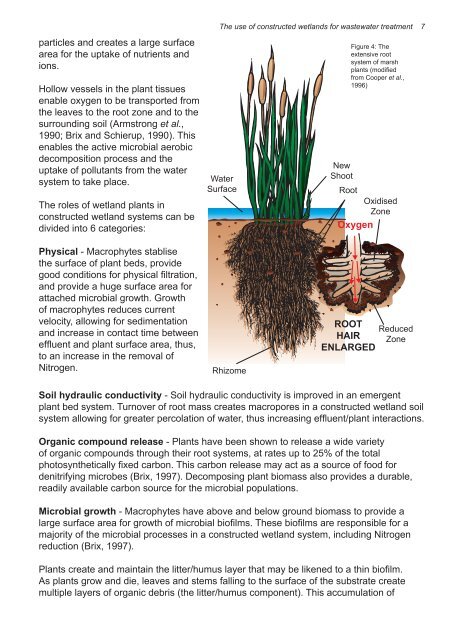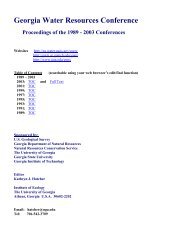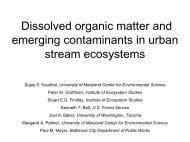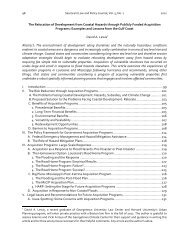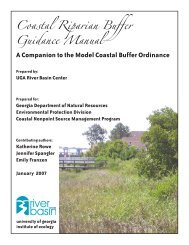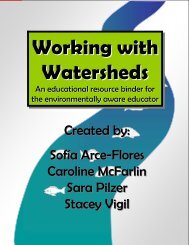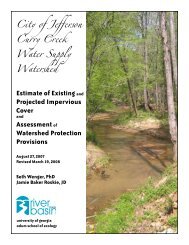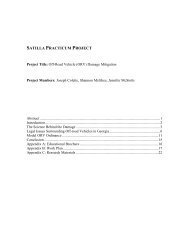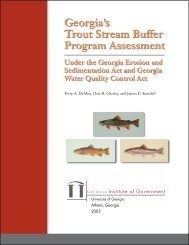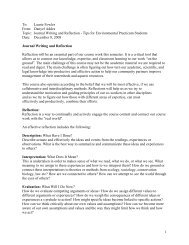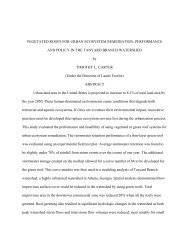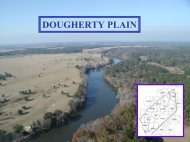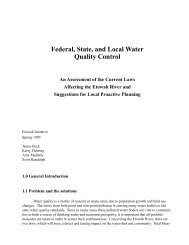The use of constructed wetlands for wastewater treatment
The use of constructed wetlands for wastewater treatment
The use of constructed wetlands for wastewater treatment
Create successful ePaper yourself
Turn your PDF publications into a flip-book with our unique Google optimized e-Paper software.
<strong>The</strong> <strong>use</strong> <strong>of</strong> <strong>constructed</strong> <strong>wetlands</strong> <strong>for</strong> <strong>wastewater</strong> <strong>treatment</strong><br />
7<br />
particles and creates a large surface<br />
area <strong>for</strong> the uptake <strong>of</strong> nutrients and<br />
ions.<br />
Hollow vessels in the plant tissues<br />
enable oxygen to be transported from<br />
the leaves to the root zone and to the<br />
surrounding soil (Armstrong et al.,<br />
1990; Brix and Schierup, 1990). This<br />
enables the active microbial aerobic<br />
decomposition process and the<br />
uptake <strong>of</strong> pollutants from the water<br />
system to take place.<br />
<strong>The</strong> roles <strong>of</strong> wetland plants in<br />
<strong>constructed</strong> wetland systems can be<br />
divided into 6 categories:<br />
Water<br />
Surface<br />
New<br />
Shoot<br />
Figure 4: <strong>The</strong><br />
extensive root<br />
system <strong>of</strong> marsh<br />
plants (modified<br />
from Cooper et al.,<br />
1996)<br />
Root<br />
Oxidised<br />
Zone<br />
Oxygen<br />
Physical - Macrophytes stablise<br />
the surface <strong>of</strong> plant beds, provide<br />
good conditions <strong>for</strong> physical filtration,<br />
and provide a huge surface area <strong>for</strong><br />
attached microbial growth. Growth<br />
<strong>of</strong> macrophytes reduces current<br />
velocity, allowing <strong>for</strong> sedimentation<br />
and increase in contact time between<br />
effluent and plant surface area, thus,<br />
to an increase in the removal <strong>of</strong><br />
Nitrogen.<br />
Rhizome<br />
ROOT<br />
HAIR<br />
ENLARGED<br />
Reduced<br />
Zone<br />
Soil hydraulic conductivity - Soil hydraulic conductivity is improved in an emergent<br />
plant bed system. Turnover <strong>of</strong> root mass creates macropores in a <strong>constructed</strong> wetland soil<br />
system allowing <strong>for</strong> greater percolation <strong>of</strong> water, thus increasing effluent/plant interactions.<br />
Organic compound release - Plants have been shown to release a wide variety<br />
<strong>of</strong> organic compounds through their root systems, at rates up to 25% <strong>of</strong> the total<br />
photosynthetically fixed carbon. This carbon release may act as a source <strong>of</strong> food <strong>for</strong><br />
denitrifying microbes (Brix, 1997). Decomposing plant biomass also provides a durable,<br />
readily available carbon source <strong>for</strong> the microbial populations.<br />
Microbial growth - Macrophytes have above and below ground biomass to provide a<br />
large surface area <strong>for</strong> growth <strong>of</strong> microbial bi<strong>of</strong>ilms. <strong>The</strong>se bi<strong>of</strong>ilms are responsible <strong>for</strong> a<br />
majority <strong>of</strong> the microbial processes in a <strong>constructed</strong> wetland system, including Nitrogen<br />
reduction (Brix, 1997).<br />
Plants create and maintain the litter/humus layer that may be likened to a thin bi<strong>of</strong>ilm.<br />
As plants grow and die, leaves and stems falling to the surface <strong>of</strong> the substrate create<br />
multiple layers <strong>of</strong> organic debris (the litter/humus component). This accumulation <strong>of</strong>


